Stones from the Namaqualand desert
4 posters
Page 1 of 1
 Stones from the Namaqualand desert
Stones from the Namaqualand desert
Hi stoners
This is my first stone post. Iv'e always been interested in rocks, long before I knew about bonsai.
Here is a couple of my stones, dont know if any could ever be suiseki or deserves a daiza. Please tell me what you stoners think.
All these stones were picked up in the Namaqualand Desert in 2005. All came from a dry river flood plane in about 100m radius, what was so incredible was all the different stones thrown together, and some more eroded than others. It hardly ever rains in Namaqualand except in the winter, then the rivers run, but for a very short time only.
Namaqualnad is famous for its flowers appearing after the first rains. Plains are flooded with namaqualand daisies.
Namaqualand full of daisies...
1.
It also has these areas of white quarts cristals. In these areas the normal vegetation does'nt grow, and the plants that do grow there, are nothing higher than the quarts. All are succulents ,and some immitate the quarts around them.
The first photo shows the quarts patches, one can see them in the distance too, the second photo shows the white quarts patches with flowering agryderma.
2.
3.
This stone is 17cm in lenth and is the second biggest one I picked up. A year later I noticed the succulent that germinated on the stone!! The seed must have lodged itself in the rock and when I brought it home , it germinated, its the same plants as in the second photo, this plant is now 6 years old and about a tenth the size of an normal specimen. Can you call this a 'suiseki bonsai'!! just kidding.
4.
White quarts with cristals
5.
A quarts stone, - mountain with a lake
6.
This is one of the first ones I picked up, it reminds me of mountains in Italy with Marble vaines running through them, a beautifull stone full of caverns and grottos, the base is flat. Its totally natural and has never been chipped.
7.
There were losts with this kind of pattern on them, it looks as if it has been eaten by a worm, what is strange is that you get pebbles with this pattern on it, ... so it was first eroded in a river, which made it smooth and round, and then I suppose it was eroded slowly in the desert. The colour is also almost blue.
8.
These are the 'eaten' pebbles, how long have they been weathered....millions of years?
9.
Another one with the pattern radiating from the centre, in other words this pebble has been lying in that position for hundreds of years for it to be eroded in this way...by rain ( I'm not the expert here, this is what logic tells me. But isnt it amazing??
10.
Is this red Ochre, look at the bamboo. And look how smooth it is, compare with the others
11.
This is one of my favourites, the granite is almost blue and the quarts white, reminds me of a rock sitting in the waves on the shore.
12.
A very flat stone with unbelievable tecture, it can also be put on its end, so it looks like a pinacle
13.
14.
15.
Look at this fantastic black pebble eroded so finely its looks like lace
16.
And then these two pebbles ....? strange isnt it?
17.
This is heated slate, I think, but looks like the contorted mountains of sandstone. Isnt it amazing?
18.
19.
This stone reminds me of those Eastern paintinngs of mountains in the mist
20.
Another mountain with a lake ontop
21.
And the back with a shelter or grotto
22.
My last photo is of sand that I collected on a beach on the westcoast also in Namaqualand. It is in the Diamond fields where they mine the alluvial diamonds. This entire beach is made of crushed Garnets!!
23.

isnt it awesome?
Kindest regards
Andre
This is my first stone post. Iv'e always been interested in rocks, long before I knew about bonsai.
Here is a couple of my stones, dont know if any could ever be suiseki or deserves a daiza. Please tell me what you stoners think.
All these stones were picked up in the Namaqualand Desert in 2005. All came from a dry river flood plane in about 100m radius, what was so incredible was all the different stones thrown together, and some more eroded than others. It hardly ever rains in Namaqualand except in the winter, then the rivers run, but for a very short time only.
Namaqualnad is famous for its flowers appearing after the first rains. Plains are flooded with namaqualand daisies.
Namaqualand full of daisies...
1.

It also has these areas of white quarts cristals. In these areas the normal vegetation does'nt grow, and the plants that do grow there, are nothing higher than the quarts. All are succulents ,and some immitate the quarts around them.
The first photo shows the quarts patches, one can see them in the distance too, the second photo shows the white quarts patches with flowering agryderma.
2.

3.

This stone is 17cm in lenth and is the second biggest one I picked up. A year later I noticed the succulent that germinated on the stone!! The seed must have lodged itself in the rock and when I brought it home , it germinated, its the same plants as in the second photo, this plant is now 6 years old and about a tenth the size of an normal specimen. Can you call this a 'suiseki bonsai'!! just kidding.
4.

White quarts with cristals
5.

A quarts stone, - mountain with a lake
6.

This is one of the first ones I picked up, it reminds me of mountains in Italy with Marble vaines running through them, a beautifull stone full of caverns and grottos, the base is flat. Its totally natural and has never been chipped.
7.

There were losts with this kind of pattern on them, it looks as if it has been eaten by a worm, what is strange is that you get pebbles with this pattern on it, ... so it was first eroded in a river, which made it smooth and round, and then I suppose it was eroded slowly in the desert. The colour is also almost blue.
8.

These are the 'eaten' pebbles, how long have they been weathered....millions of years?
9.

Another one with the pattern radiating from the centre, in other words this pebble has been lying in that position for hundreds of years for it to be eroded in this way...by rain ( I'm not the expert here, this is what logic tells me. But isnt it amazing??
10.

Is this red Ochre, look at the bamboo. And look how smooth it is, compare with the others
11.

This is one of my favourites, the granite is almost blue and the quarts white, reminds me of a rock sitting in the waves on the shore.
12.

A very flat stone with unbelievable tecture, it can also be put on its end, so it looks like a pinacle
13.

14.

15.

Look at this fantastic black pebble eroded so finely its looks like lace
16.

And then these two pebbles ....? strange isnt it?
17.

This is heated slate, I think, but looks like the contorted mountains of sandstone. Isnt it amazing?
18.

19.

This stone reminds me of those Eastern paintinngs of mountains in the mist
20.

Another mountain with a lake ontop
21.

And the back with a shelter or grotto
22.

My last photo is of sand that I collected on a beach on the westcoast also in Namaqualand. It is in the Diamond fields where they mine the alluvial diamonds. This entire beach is made of crushed Garnets!!
23.


isnt it awesome?
Kindest regards
Andre

Andre Beaurain- Member
 Re: Stones from the Namaqualand desert
Re: Stones from the Namaqualand desert
Hi Andre
Welcome to this forum.
This is a wonderful desert you find your stones awesome in....Many of them would really benefit from being placed in a daiza....Begin to carve, it gives a great dimension to the stonefinding...you have to try, to know
I was very happy to see your stone nr. 9, as I have a stone like this, now I know where my comes from, and that it is for real....my stone also have a unusual shape, so I somehow had my doubts. Now I am confident, and can't wait to carve a daiza for the stone.
Hope to hear much more from you in the future.
Kind regards Yvonne
Welcome to this forum.
This is a wonderful desert you find your stones awesome in....Many of them would really benefit from being placed in a daiza....Begin to carve, it gives a great dimension to the stonefinding...you have to try, to know
I was very happy to see your stone nr. 9, as I have a stone like this, now I know where my comes from, and that it is for real....my stone also have a unusual shape, so I somehow had my doubts. Now I am confident, and can't wait to carve a daiza for the stone.
Hope to hear much more from you in the future.
Kind regards Yvonne
Guest- Guest
 Re: Stones from the Namaqualand desert
Re: Stones from the Namaqualand desert
Hello Andre,
What a beautiful picture no 1
and what a finding source it must be there in S- Africa!
They are all nice.
No 10 reminds me of some fossils.
My personal favourites are no 8
18-19, 20 and 22
regards Sunip
What a beautiful picture no 1
and what a finding source it must be there in S- Africa!
They are all nice.
No 10 reminds me of some fossils.
My personal favourites are no 8
18-19, 20 and 22
regards Sunip
sunip- Member
 Re: Stones from the Namaqualand desert
Re: Stones from the Namaqualand desert
Hi Andre
Many thanks for your reply....10 and 20 looks like stones, that could be fairly easy for a beginer to start with.
Sink them in the wood, and post the picture here, And I am sure designhelp will be given to you.
Kind regards Yvonne
Many thanks for your reply....10 and 20 looks like stones, that could be fairly easy for a beginer to start with.
Sink them in the wood, and post the picture here, And I am sure designhelp will be given to you.
Kind regards Yvonne
Guest- Guest
 Re: Stones from the Namaqualand desert
Re: Stones from the Namaqualand desert
Hi Andre... Thanks for posting. WELCOME TO THE FORUM!!! I was traveling, yesterday, to present an illustrated lecture on Chinese scholar rock aesthetics for Potomac Viewing Stone Group. It was a beautiful day at the U.S. National Arboretum. Inside the Natl. Bonsai & Penjing Museum was an exhibition of ikebana. A few photos...
Ikebana in alcove...
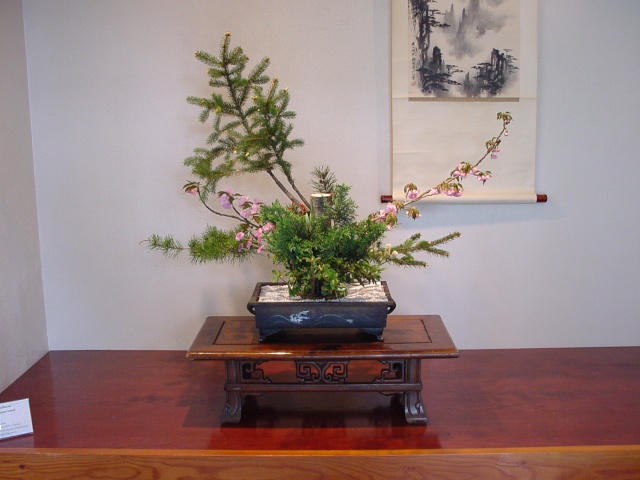
Ikebana in exhibit on lengthy raised cabinet(s)...
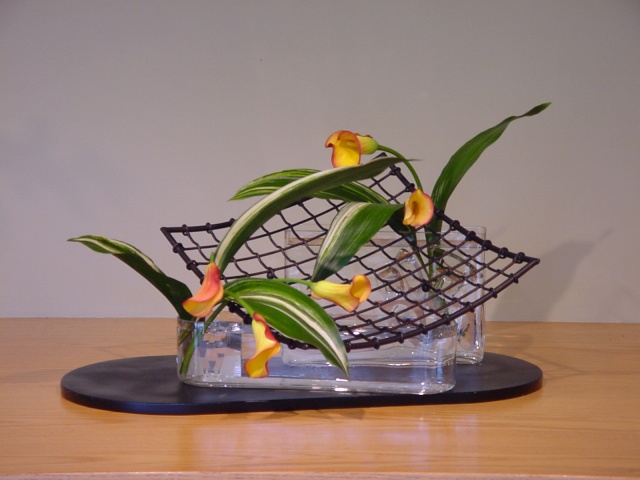
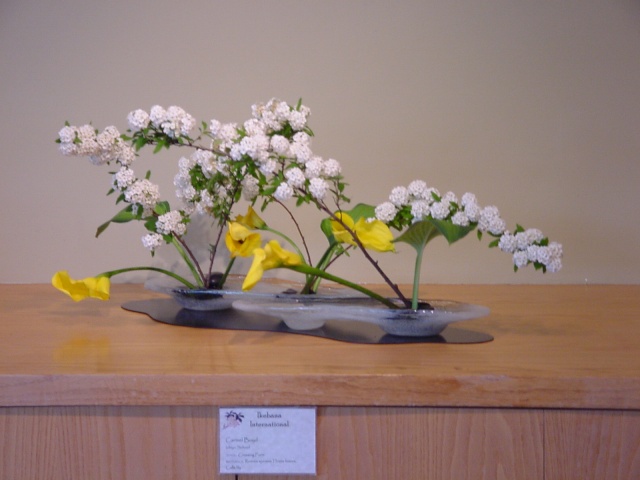
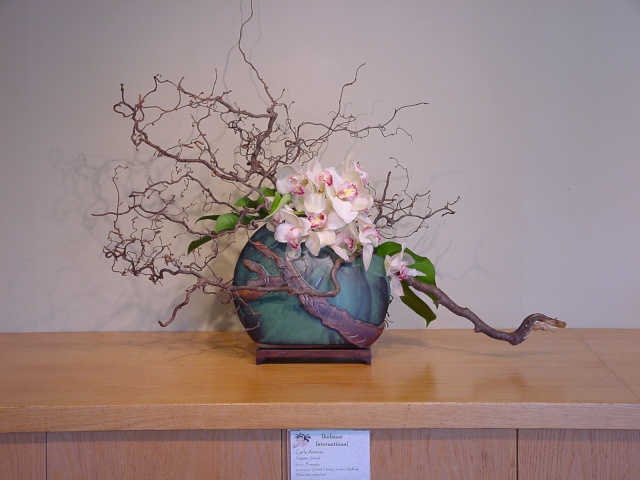

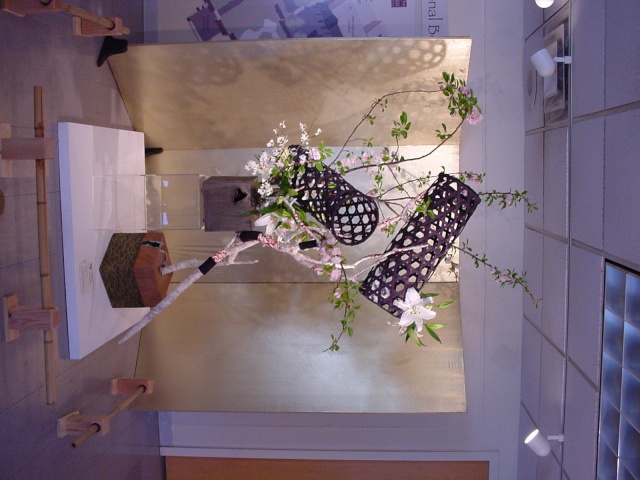
Ooops... Please excuse the slight lean of the last two photos... ;-)
Desert stone collecting applies to modern shangshi collecting in China; it is not source of traditional stone collecting of either China or Japan. What is most highly sought in shangshi are stones which relate a story. As an interesting, lovely object without relating strikingly beyond itself, a stone is more a geological specimen sought by rockhounds rather than a viewing stone. It is arguably similar to the difference of a lovely flower or tree branch from a flower or branch chosen for ikebana display, which carries layers of meaning relating to season, emotion, an idealized universe, directed movement, unity & quiet/solitude.
For advice on choosing & displaying desert stones, you might read the archived newsletters of California Aiseki Kai (linked HERE), whose members mount stones for exhibition in Japanese suiseki-style. Some might argue that desert stones (especially those with fragile desert varnish) can never be suiseki; it is a valid argument but does not exclude their appreciation as viewing stones with unique character-- especially, for those which suggest desert landscapes.
Ikebana in alcove...

Ikebana in exhibit on lengthy raised cabinet(s)...





Ooops... Please excuse the slight lean of the last two photos... ;-)
Desert stone collecting applies to modern shangshi collecting in China; it is not source of traditional stone collecting of either China or Japan. What is most highly sought in shangshi are stones which relate a story. As an interesting, lovely object without relating strikingly beyond itself, a stone is more a geological specimen sought by rockhounds rather than a viewing stone. It is arguably similar to the difference of a lovely flower or tree branch from a flower or branch chosen for ikebana display, which carries layers of meaning relating to season, emotion, an idealized universe, directed movement, unity & quiet/solitude.
For advice on choosing & displaying desert stones, you might read the archived newsletters of California Aiseki Kai (linked HERE), whose members mount stones for exhibition in Japanese suiseki-style. Some might argue that desert stones (especially those with fragile desert varnish) can never be suiseki; it is a valid argument but does not exclude their appreciation as viewing stones with unique character-- especially, for those which suggest desert landscapes.

Chris Cochrane- Member
 Re: Stones from the Namaqualand desert
Re: Stones from the Namaqualand desert
Thanks Sunip.
Nr 10 does look a little like Siluriann Coral am I right, is that what you saw in it? Its because of the radiating pattern, I think.
I'm also glad that Yvonne recomended that I make a daiza for it first, and nr 20.
Chris, thanks for the insight, I read the newsletter, and their definition of suiseki. The icabana are all shit.
" Further, to be classified as suiseki, the material must be dense, dark in color and possess a subtle patina."
But you do get those in Deserts.
So why cant desert stones be calassified as suiseki? And why cant light coloured stones be classified as suiseki?
Sorry I'm learning, and I only have one book on suiseki. And nothing is said about the colour or place of origin.
Is this Suiseki:

Nr 10 does look a little like Siluriann Coral am I right, is that what you saw in it? Its because of the radiating pattern, I think.
I'm also glad that Yvonne recomended that I make a daiza for it first, and nr 20.
Chris, thanks for the insight, I read the newsletter, and their definition of suiseki. The icabana are all shit.
" Further, to be classified as suiseki, the material must be dense, dark in color and possess a subtle patina."
But you do get those in Deserts.
So why cant desert stones be calassified as suiseki? And why cant light coloured stones be classified as suiseki?
Sorry I'm learning, and I only have one book on suiseki. And nothing is said about the colour or place of origin.
Is this Suiseki:


Andre Beaurain- Member
 Re: Stones from the Namaqualand desert
Re: Stones from the Namaqualand desert
Hello Andre,Andre Beaurain wrote:Thanks Sunip.
Nr 10 does look a little like Siluriann Coral am I right, is that what you saw in it? Its because of the radiating pattern, I think.
So why cant desert stones be calassified as suiseki? And why cant light coloured stones be classified as suiseki?
Indeed they look like some fossils i found in Spain.
Some will name it suiseki like a bonsai is called a bonsai internationally.
It is a bit confusing maybe but then, suiseki is about Japanese viewing stones only,
it is about Japanese stones, culture and taste.
This does not mean other stones cant be viewing stones or presented in Japanese style.
So now we know of a Japanese, Chinese, Korean or western style, do we get a S - African style?
Sunip
sunip- Member
 Re: Stones from the Namaqualand desert
Re: Stones from the Namaqualand desert
Hi Andre
You really have to get your hands in japanese suisekibooks, as you will be surpriced to see many pale suiseki, and suiseki that could look a little like your desertstones...I could send you the first 12 photos of pale japanese suiseki, with shapes not described here on IBC.
So go for it, no holding back, use the stones from your country, they will give you one dimetion more.
I prefer stones that can be placed in the old japanese list of types, as I they give me the feeling and tradition I want.
Like the japanese stones, has far from all danish stones I find it all, but it does not keep me from enjoying them...keeping in mind, I might in the future find the stone with all the wished for shapes. Hope is green, and it is stones from my country.
Western Desert mountainstones became last year a member of stones to be classified as suiseki/viewingstones.
I have seen no rules for, how they should be exhibited..but my guess is, a suiban with sand, without water is nice....but...All suiseki/viewingstones should have a seat/daiza to proteckt them, and give them honour in the daily life. Also to show them, in the angle they look the best, every day.
I dont think I am allowed to send the photos on IBC, but I can send them to you in privacy if you are interested.
Kind regards Yvonne
You really have to get your hands in japanese suisekibooks, as you will be surpriced to see many pale suiseki, and suiseki that could look a little like your desertstones...I could send you the first 12 photos of pale japanese suiseki, with shapes not described here on IBC.
So go for it, no holding back, use the stones from your country, they will give you one dimetion more.
I prefer stones that can be placed in the old japanese list of types, as I they give me the feeling and tradition I want.
Like the japanese stones, has far from all danish stones I find it all, but it does not keep me from enjoying them...keeping in mind, I might in the future find the stone with all the wished for shapes. Hope is green, and it is stones from my country.
Western Desert mountainstones became last year a member of stones to be classified as suiseki/viewingstones.
I have seen no rules for, how they should be exhibited..but my guess is, a suiban with sand, without water is nice....but...All suiseki/viewingstones should have a seat/daiza to proteckt them, and give them honour in the daily life. Also to show them, in the angle they look the best, every day.
I dont think I am allowed to send the photos on IBC, but I can send them to you in privacy if you are interested.
Kind regards Yvonne
Guest- Guest
 Re: Stones from the Namaqualand desert
Re: Stones from the Namaqualand desert
Thanks again Sunip for that info.
Africa doesnt have any Style....we've got Rhythm


I actually dont understand your question... Style in what? Are you tlaking about bonsai or stones, or fashion for that matter.
If you are talking about stones.... no we dont have any style in stone, if we pick up a stone, its to throw it, or turn it into something usefull. ha ha ha haa.
If you are talking about Bonsai..... then there is the..... Pierneef Style, but o dear, I'm not going to go there again, Max is lurking somewhere in the Shadows. .... ,that was a joke. I love you Max.
So if suiseki is exclusively for Japanese, in Japan with Japanese stone, Why are we studying it then, surely we do this to partake in the art. Its like telling a potter, you can study the art of pottery, but you are not allowed to touch the clay. Follow my drift? My wish is to own a stone oneday that I can call Suiseki. I would be very very happy, if it is a stone that I already own. But now you tell me that only stones from Japan can be called Suiseki. I'm devastated.
Yvonne help, tell Sunip this isnt true!
Africa doesnt have any Style....we've got Rhythm
I actually dont understand your question... Style in what? Are you tlaking about bonsai or stones, or fashion for that matter.
If you are talking about stones.... no we dont have any style in stone, if we pick up a stone, its to throw it, or turn it into something usefull. ha ha ha haa.
If you are talking about Bonsai..... then there is the..... Pierneef Style, but o dear, I'm not going to go there again, Max is lurking somewhere in the Shadows. .... ,that was a joke. I love you Max.
So if suiseki is exclusively for Japanese, in Japan with Japanese stone, Why are we studying it then, surely we do this to partake in the art. Its like telling a potter, you can study the art of pottery, but you are not allowed to touch the clay. Follow my drift? My wish is to own a stone oneday that I can call Suiseki. I would be very very happy, if it is a stone that I already own. But now you tell me that only stones from Japan can be called Suiseki. I'm devastated.
Yvonne help, tell Sunip this isnt true!

Andre Beaurain- Member
 Re: Stones from the Namaqualand desert
Re: Stones from the Namaqualand desert
Yvonne, thats great, I would love to see the photos. Please
I also looked at stone nr 10 and thought that it would be happier in a sand suban than in a daiza? What about the Garnet sand? O I'm gonna do that tonight.
Love and light
Andre
I also looked at stone nr 10 and thought that it would be happier in a sand suban than in a daiza? What about the Garnet sand? O I'm gonna do that tonight.
Love and light
Andre

Andre Beaurain- Member
 Re: Stones from the Namaqualand desert
Re: Stones from the Namaqualand desert
[quote="Andre Beaurain"]
So if suiseki is exclusively for Japanese, in Japan with Japanese stone, Why are we studying it then, surely we do this to partake in the art.
Hello Andre,
It is quit academic really.
Suiseki is a Japanese viewing stone thats all, no rules only if you want.
That is why i said 'South Africa Style' just to encourage you to appreciate your own stones.
The Japanese suiseki culture is most refined, reason why many stone collectors study their practice.
In the post of Chris he is talking about ''mounting a stone in Japanese suiseki-style, but in academic definition it is not a suiseki,
this does not exclude their appreciation as viewing stone''
Personally i look at stones not at rules, Chris post i think is a representation of an academic approach, so no rule here either,
only a tool for communication and study, so we get not lost.
In Japan there are all sorts of schools but again when a Japanese says your stone is not an suiseki it can be frustrating.
This makes your stone however not less valuable as it is a thing of its own.
The question; 'Why is my stone not a suiseki' comes on a regular basis to this forum,
but it is good to look at it again to get this in perspective.
I am no expert in this field, so i hope others will shed their light as they have don already.
Maybe we can settle for African Viewingstone-Suiseki?
Sunip
So if suiseki is exclusively for Japanese, in Japan with Japanese stone, Why are we studying it then, surely we do this to partake in the art.
Hello Andre,
It is quit academic really.
Suiseki is a Japanese viewing stone thats all, no rules only if you want.
That is why i said 'South Africa Style' just to encourage you to appreciate your own stones.
The Japanese suiseki culture is most refined, reason why many stone collectors study their practice.
In the post of Chris he is talking about ''mounting a stone in Japanese suiseki-style, but in academic definition it is not a suiseki,
this does not exclude their appreciation as viewing stone''
Personally i look at stones not at rules, Chris post i think is a representation of an academic approach, so no rule here either,
only a tool for communication and study, so we get not lost.
In Japan there are all sorts of schools but again when a Japanese says your stone is not an suiseki it can be frustrating.
This makes your stone however not less valuable as it is a thing of its own.
The question; 'Why is my stone not a suiseki' comes on a regular basis to this forum,
but it is good to look at it again to get this in perspective.
I am no expert in this field, so i hope others will shed their light as they have don already.
Maybe we can settle for African Viewingstone-Suiseki?
Sunip
sunip- Member
 Re: Stones from the Namaqualand desert
Re: Stones from the Namaqualand desert
Andre Beaurain wrote:Yvonne, thats great, I would love to see the photos. Please
I also looked at stone nr 10 and thought that it would be happier in a sand suban than in a daiza? What about the Garnet sand? O I'm gonna do that tonight.
Love and light
Andre
Love and light....nice
Your pretty garnetsand is not usefull for a stone displayed in the modest japanese way...you must find sand in a quet collour, that gives the viewer the impression of the dessert/nature...the right feeling...your suiban must have a collour that fits the impression.
To understand the way of suiseki takes a long time, and some people never will. However this should, and does not hold people back, from being fully able to enjoy a landskapestone in a fittet wellcarved woodstand.
Western people has adopted the name suiseki, and daiza, and the japanese names for the diffrent styles, this is not a problem at all, feel free to call your stone in a suiban or seat, suiseki and daiza. The western words are slowly growing stronger, but like everything else, does it take the time.
If you inbetween go to Japan like I do, will you learn something else. In my early suisekidays. When I spoke with a suisekilover, and I told him. I love suiseki, and have some in my home. He would be delighted, and happy I collected japanese stones...If I then said. I also collect danish suiseki, the conversation was already ower. Japanese stonelovers who are in contact with the west, does not have this problem, they understand tings takes time.
For now, just enjoy.
I will send the photos later.
Kind regards Yvonne
Guest- Guest
 Re: Stones from the Namaqualand desert
Re: Stones from the Namaqualand desert
Thankyou Yvonne
I'm beginning to understand....
Its a bit like Champagne.. We are not allowed, to call our Sparkling wine Champagne, its only when you live and produce in France in Champagne that you can call it that.
But its doesnt stop us from calling it still Champagne, when talk about it amongs ourselves.
Is actually about Pride.
I'm beginning to understand....
Its a bit like Champagne.. We are not allowed, to call our Sparkling wine Champagne, its only when you live and produce in France in Champagne that you can call it that.
But its doesnt stop us from calling it still Champagne, when talk about it amongs ourselves.
Is actually about Pride.

Andre Beaurain- Member
 small steps at first
small steps at first
Soon Andre you will learn to run!
My bonsai teacher John Naka told me!
"It is what you see!"
On a trip to Africa he brought back some stones,
Later made this own stands and now considered famous stones!
He once told me, "you must know the rules! so you know how to break them!"
use the Japanese rules as refined guidelines applied to your own African found stones.
no books? you got internet! the world is on your screen, feed on it...
Malachite picture you asked "is this suiseki?" would be called in Japanese BI-SEKI
Google to read more...
*research AisekiKai news letter*
for Ralph Johnson's famous African Malachite collections
Oh! About that garnet sand! would look fantastic in my aquarium,
can I get 100lbs or so???...
My bonsai teacher John Naka told me!
"It is what you see!"
On a trip to Africa he brought back some stones,
Later made this own stands and now considered famous stones!
He once told me, "you must know the rules! so you know how to break them!"
use the Japanese rules as refined guidelines applied to your own African found stones.
no books? you got internet! the world is on your screen, feed on it...
Malachite picture you asked "is this suiseki?" would be called in Japanese BI-SEKI
Google to read more...
*research AisekiKai news letter*
for Ralph Johnson's famous African Malachite collections
Oh! About that garnet sand! would look fantastic in my aquarium,
can I get 100lbs or so???...
stonener- Member
 Re: Stones from the Namaqualand desert
Re: Stones from the Namaqualand desert
Morning Stoners
Sunip yea I tink the stone belongs to the China museum, it was on display at the 2010 Guangzhou international show.
Stoner ...that is really fasinating...and the rabbit hole gets deeper...
Yes the Garnet sand is quite remarkable, I nearlly fainted when I saw the beach, which wasnt very big, about a hundred metres or so in length, between bolder outcrops. The sea is also pretty violent there, and ice cold. The garnets does mix with 'normal' sea sand, something to do with the density. I shlould have bagged alot more, but we were invited guests in the Diamond fields, we had to help with the rehabilitation of sandfield plants on the open pit mines. The chances to go there again is almost zero.
I also picked up this stone! Its 105mm x 75 mm
Who can tell me what it is?

Sunip yea I tink the stone belongs to the China museum, it was on display at the 2010 Guangzhou international show.
Stoner ...that is really fasinating...and the rabbit hole gets deeper...
Yes the Garnet sand is quite remarkable, I nearlly fainted when I saw the beach, which wasnt very big, about a hundred metres or so in length, between bolder outcrops. The sea is also pretty violent there, and ice cold. The garnets does mix with 'normal' sea sand, something to do with the density. I shlould have bagged alot more, but we were invited guests in the Diamond fields, we had to help with the rehabilitation of sandfield plants on the open pit mines. The chances to go there again is almost zero.
I also picked up this stone! Its 105mm x 75 mm
Who can tell me what it is?


Andre Beaurain- Member
 Re: Stones from the Namaqualand desert
Re: Stones from the Namaqualand desert
The beach sound awesome...would like to see a photo of it.
The stone looks like it once was a piece of bone.
Kind regards Yvonne
The stone looks like it once was a piece of bone.
Kind regards Yvonne
Guest- Guest
 Re: Stones from the Namaqualand desert
Re: Stones from the Namaqualand desert
Afternoon stoners
Yvonne yes, the stone is dinosaur bone.
I did not take any pictures of the beach, stupid I know, but I just Google earth it and you can actually see the Garnet beach slightly to the north of Hondeklipbaai. I thought there was only one beach, now I can see there is two smaller ones between the boulders!!
Hondeklipbaai, Northern Cape.
http://maps.google.com/maps?q=HONDEKLIPBAAI1,+Hondeklip+Bay,+Northern+Cape,+South+Africa&hl=en&ll=-30.305748,17.272713&spn=0.003511,0.004769&sll=-30.306327,17.272578&sspn=0.003511,0.004769&oq=HONDEKLIPBAAI&t=h&hnear=HONDEKLIPBAAI1,+Hondeklip+Bay,+Namakwa,+Northern+Cape+8222,+South+Africa&z=18
Yvonne yes, the stone is dinosaur bone.
I did not take any pictures of the beach, stupid I know, but I just Google earth it and you can actually see the Garnet beach slightly to the north of Hondeklipbaai. I thought there was only one beach, now I can see there is two smaller ones between the boulders!!
Hondeklipbaai, Northern Cape.
http://maps.google.com/maps?q=HONDEKLIPBAAI1,+Hondeklip+Bay,+Northern+Cape,+South+Africa&hl=en&ll=-30.305748,17.272713&spn=0.003511,0.004769&sll=-30.306327,17.272578&sspn=0.003511,0.004769&oq=HONDEKLIPBAAI&t=h&hnear=HONDEKLIPBAAI1,+Hondeklip+Bay,+Namakwa,+Northern+Cape+8222,+South+Africa&z=18

Andre Beaurain- Member
 No bone! C fish!
No bone! C fish!
Hey Andre!
from this angle I see a happy fish...
darting in ruff white foam of surf?...
from this angle I see a happy fish...

darting in ruff white foam of surf?...
stonener- Member
 Similar topics
Similar topics» Stones for beginners
» desert rose
» my collection
» Since I can't live in the desert any more . . .
» desert rose
» desert rose
» my collection
» Since I can't live in the desert any more . . .
» desert rose
Page 1 of 1
Permissions in this forum:
You cannot reply to topics in this forum






